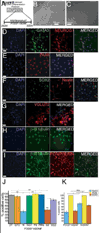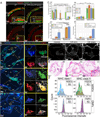An engineered three-dimensional stem cell niche in the inner ear by applying a nanofibrillar cellulose hydrogel with a sustained-release neurotrophic factor delivery system
- PMID: 32156626
- PMCID: PMC7198367
- DOI: 10.1016/j.actbio.2020.03.007
An engineered three-dimensional stem cell niche in the inner ear by applying a nanofibrillar cellulose hydrogel with a sustained-release neurotrophic factor delivery system
Abstract
Although the application of human embryonic stem cells (hESCs) in stem cell-replacement therapy remains promising, its potential is hindered by a low cell survival rate in post-transplantation within the inner ear. Here, we aim to enhance the in vitro and in vivo survival rate and neuronal differentiation of otic neuronal progenitors (ONPs) by generating an artificial stem cell niche consisting of three-dimensional (3D) hESC-derived ONP spheroids with a nanofibrillar cellulose hydrogel and a sustained-release brain-derivative neurotrophic factor delivery system. Our results demonstrated that the transplanted hESC-derived ONP spheroids survived and neuronally differentiated into otic neuronal lineages in vitro and in vivo and also extended neurites toward the bony wall of the cochlea 90 days after the transplantation without the use of immunosuppressant medication. Our data in vitro and in vivo presented here provide sufficient evidence that we have established a robust, reproducible protocol for in vivo transplantation of hESC-derived ONPs to the inner ear. Using our protocol to create an artificial stem cell niche in the inner ear, it is now possible to work on integrating transplanted hESC-derived ONPs further and also to work toward achieving functional auditory neurons generated from hESCs. Our findings suggest that the provision of an artificial stem cell niche can be a future approach to stem cell-replacement therapy for inner-ear regeneration. STATEMENT OF SIGNIFICANCE: Inner ear regeneration utilizing human embryonic stem cell-derived otic neuronal progenitors (hESC-derived ONPs) has remarkable potential for treating sensorineural hearing loss. However, the local environment of the inner ear requires a suitable stem cell niche to allow hESC-derived ONP engraftment as well as neuronal differentiation. To overcome this obstacle, we utilized three-dimensional spheroid formation (direct contact), nanofibrillar cellulose hydrogel (extracellular matrix), and a neurotrophic factor delivery system to artificially create a stem cell niche in vitro and in vivo. Our in vitro and in vivo data presented here provide sufficient evidence that we have established a robust, reproducible protocol for in vivo transplantation of hESC-derived ONPs to the inner ear.
Keywords: Human embryonic stem cells; Human pluripotent stem cells; Hydrogel; Spiral ganglion neurons; Stem cell niche; Stem cell–replacement therapy; The inner ear.
Copyright © 2020. Published by Elsevier Ltd.
Conflict of interest statement
Declaration of Competing Interest The authors declare that they have no known competing financial interests or personal relationships that could have appeared to influence the work reported in this paper.
Figures









Similar articles
-
Three-Dimensional Otic Neuronal Progenitor Spheroids Derived from Human Embryonic Stem Cells.Tissue Eng Part A. 2021 Feb;27(3-4):256-269. doi: 10.1089/ten.TEA.2020.0078. Epub 2020 Aug 7. Tissue Eng Part A. 2021. PMID: 32580647 Free PMC article.
-
Creating a stem cell niche in the inner ear using self-assembling peptide amphiphiles.PLoS One. 2017 Dec 28;12(12):e0190150. doi: 10.1371/journal.pone.0190150. eCollection 2017. PLoS One. 2017. PMID: 29284013 Free PMC article.
-
Bridging the electrode-neuron gap: finite element modeling of in vitro neurotrophin gradients to optimize neuroelectronic interfaces in the inner ear.Acta Biomater. 2022 Oct 1;151:360-378. doi: 10.1016/j.actbio.2022.08.035. Epub 2022 Aug 22. Acta Biomater. 2022. PMID: 36007779
-
Building an Artificial Stem Cell Niche: Prerequisites for Future 3D-Formation of Inner Ear Structures-Toward 3D Inner Ear Biotechnology.Anat Rec (Hoboken). 2020 Mar;303(3):408-426. doi: 10.1002/ar.24067. Epub 2019 Jan 28. Anat Rec (Hoboken). 2020. PMID: 30635991 Free PMC article. Review.
-
A human induced pluripotent stem cell-based modular platform to challenge sensorineural hearing loss.Stem Cells. 2021 Jun;39(6):697-706. doi: 10.1002/stem.3346. Epub 2021 Feb 8. Stem Cells. 2021. PMID: 33522002 Free PMC article. Review.
Cited by
-
The audiogram: Detection of pure-tone stimuli in ototoxicity monitoring and assessments of investigational medicines for the inner ear.J Acoust Soc Am. 2022 Jul;152(1):470. doi: 10.1121/10.0011739. J Acoust Soc Am. 2022. PMID: 35931504 Free PMC article. Review.
-
Inner Ear Drug Delivery for Sensorineural Hearing Loss: Current Challenges and Opportunities.Front Neurosci. 2022 May 24;16:867453. doi: 10.3389/fnins.2022.867453. eCollection 2022. Front Neurosci. 2022. PMID: 35685768 Free PMC article. Review.
-
From the Matrix to the Nucleus and Back: Mechanobiology in the Light of Health, Pathologies, and Regeneration of Oral Periodontal Tissues.Biomolecules. 2021 May 31;11(6):824. doi: 10.3390/biom11060824. Biomolecules. 2021. PMID: 34073044 Free PMC article. Review.
-
Stem cells as potential therapeutics for hearing loss.Front Neurosci. 2023 Sep 7;17:1259889. doi: 10.3389/fnins.2023.1259889. eCollection 2023. Front Neurosci. 2023. PMID: 37746148 Free PMC article. Review.
-
Rapid hydrogel-based phage susceptibility test for pathogenic bacteria.Front Cell Infect Microbiol. 2022 Dec 7;12:1032052. doi: 10.3389/fcimb.2022.1032052. eCollection 2022. Front Cell Infect Microbiol. 2022. PMID: 36569196 Free PMC article.
References
-
- Glueckert R, Bitsche M, Miller JM, Zhu Y, Prieskorn DM, Altschuler RA, Schrott-Fischer A, Deafferentiation-associated changes in afferent and efferent processes in the guinea pig cochlea and afferent regeneration with chronic intrascalar brain-derived neurotrophic factor and acidic fibroblast growth factor, J. Comp. Neurol 507 (2008) 1602–1621. doi:10.1002/cne. - DOI - PubMed
Publication types
MeSH terms
Substances
Grants and funding
LinkOut - more resources
Full Text Sources
Other Literature Sources
Research Materials

